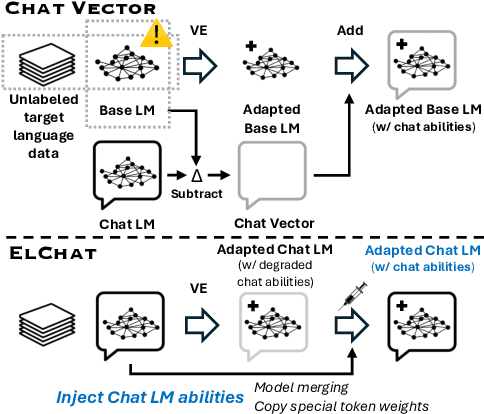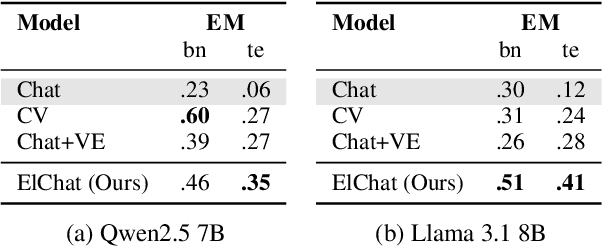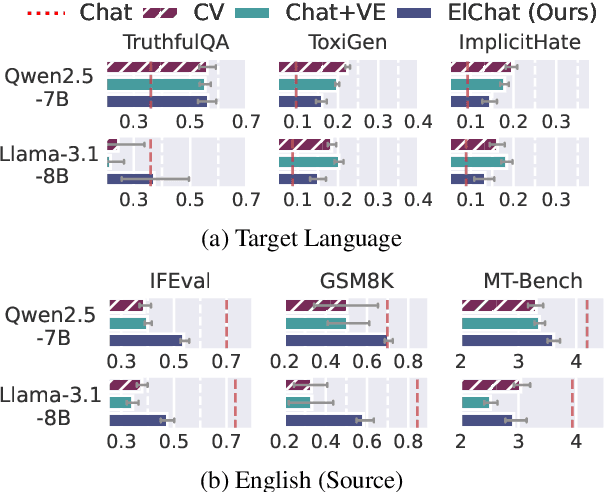Aline Villavicencio
SemEval-2025 Task 1: AdMIRe -- Advancing Multimodal Idiomaticity Representation
Mar 19, 2025Abstract:Idiomatic expressions present a unique challenge in NLP, as their meanings are often not directly inferable from their constituent words. Despite recent advancements in Large Language Models (LLMs), idiomaticity remains a significant obstacle to robust semantic representation. We present datasets and tasks for SemEval-2025 Task 1: AdMiRe (Advancing Multimodal Idiomaticity Representation), which challenges the community to assess and improve models' ability to interpret idiomatic expressions in multimodal contexts and in multiple languages. Participants competed in two subtasks: ranking images based on their alignment with idiomatic or literal meanings, and predicting the next image in a sequence. The most effective methods achieved human-level performance by leveraging pretrained LLMs and vision-language models in mixture-of-experts settings, with multiple queries used to smooth over the weaknesses in these models' representations of idiomaticity.
Vocabulary Expansion of Chat Models with Unlabeled Target Language Data
Dec 16, 2024



Abstract:Chat models (i.e. language models trained to follow instructions through conversation with humans) outperform base models (i.e. trained solely on unlabeled data) in both conversation and general task-solving abilities. These models are generally English-centric and require further adaptation for languages that are underrepresented in or absent from their training data. A common technique for adapting base models is to extend the model's vocabulary with target language tokens, i.e. vocabulary expansion (VE), and then continually pre-train it on language-specific data. Using chat data is ideal for chat model adaptation, but often, either this does not exist or is costly to construct. Alternatively, adapting chat models with unlabeled data is a possible solution, but it could result in catastrophic forgetting. In this paper, we investigate the impact of using unlabeled target language data for VE on chat models for the first time. We first show that off-the-shelf VE generally performs well across target language tasks and models in 71% of cases, though it underperforms in scenarios where source chat models are already strong. To further improve adapted models, we propose post-hoc techniques that inject information from the source model without requiring any further training. Experiments reveal the effectiveness of our methods, helping the adapted models to achieve performance improvements in 87% of cases.
A Deep Learning Approach to Language-independent Gender Prediction on Twitter
Nov 29, 2024

Abstract:This work presents a set of experiments conducted to predict the gender of Twitter users based on language-independent features extracted from the text of the users' tweets. The experiments were performed on a version of TwiSty dataset including tweets written by the users of six different languages: Portuguese, French, Dutch, English, German, and Italian. Logistic regression (LR), and feed-forward neural networks (FFNN) with back-propagation were used to build models in two different settings: Inter-Lingual (IL) and Cross-Lingual (CL). In the IL setting, the training and testing were performed on the same language whereas in the CL, Italian and German datasets were set aside and only used as test sets and the rest were combined to compose training and development sets. In the IL, the highest accuracy score belongs to LR whereas in the CL, FFNN with three hidden layers yields the highest score. The results show that neural network based models underperform traditional models when the size of the training set is small; however, they beat traditional models by a non-trivial margin, when they are fed with large enough data. Finally, the feature analysis confirms that men and women have different writing styles independent of their language.
Investigating Idiomaticity in Word Representations
Nov 04, 2024



Abstract:Idiomatic expressions are an integral part of human languages, often used to express complex ideas in compressed or conventional ways (e.g. eager beaver as a keen and enthusiastic person). However, their interpretations may not be straightforwardly linked to the meanings of their individual components in isolation and this may have an impact for compositional approaches. In this paper, we investigate to what extent word representation models are able to go beyond compositional word combinations and capture multiword expression idiomaticity and some of the expected properties related to idiomatic meanings. We focus on noun compounds of varying levels of idiomaticity in two languages (English and Portuguese), presenting a dataset of minimal pairs containing human idiomaticity judgments for each noun compound at both type and token levels, their paraphrases and their occurrences in naturalistic and sense-neutral contexts, totalling 32,200 sentences. We propose this set of minimal pairs for evaluating how well a model captures idiomatic meanings, and define a set of fine-grained metrics of Affinity and Scaled Similarity, to determine how sensitive the models are to perturbations that may lead to changes in idiomaticity. The results obtained with a variety of representative and widely used models indicate that, despite superficial indications to the contrary in the form of high similarities, idiomaticity is not yet accurately represented in current models. Moreover, the performance of models with different levels of contextualisation suggests that their ability to capture context is not yet able to go beyond more superficial lexical clues provided by the words and to actually incorporate the relevant semantic clues needed for idiomaticity.
Rolling the DICE on Idiomaticity: How LLMs Fail to Grasp Context
Oct 21, 2024



Abstract:Human processing of idioms relies on understanding the contextual sentences in which idioms occur, as well as language-intrinsic features such as frequency and speaker-intrinsic factors like familiarity. While LLMs have shown high performance on idiomaticity detection tasks, this success may be attributed to reasoning shortcuts in existing datasets. To this end, we construct a novel, controlled contrastive dataset designed to test whether LLMs can effectively use context to disambiguate idiomatic meaning. Additionally, we explore how collocational frequency and sentence probability influence model performance. Our findings reveal that LLMs often fail to resolve idiomaticity when it is required to attend to the surrounding context, and that models perform better on sentences that have higher likelihood. The collocational frequency of expressions also impacts performance. We make our code and dataset publicly available.
Enhancing Idiomatic Representation in Multiple Languages via an Adaptive Contrastive Triplet Loss
Jun 21, 2024Abstract:Accurately modeling idiomatic or non-compositional language has been a longstanding challenge in Natural Language Processing (NLP). This is partly because these expressions do not derive their meanings solely from their constituent words, but also due to the scarcity of relevant data resources, and their impact on the performance of downstream tasks such as machine translation and simplification. In this paper we propose an approach to model idiomaticity effectively using a triplet loss that incorporates the asymmetric contribution of components words to an idiomatic meaning for training language models by using adaptive contrastive learning and resampling miners to build an idiomatic-aware learning objective. Our proposed method is evaluated on a SemEval challenge and outperforms previous alternatives significantly in many metrics.
Vocabulary Expansion for Low-resource Cross-lingual Transfer
Jun 17, 2024Abstract:Large language models (LLMs) have shown remarkable capabilities in many languages beyond English. Yet, LLMs require more inference steps when generating non-English text due to their reliance on English-centric tokenizers, vocabulary, and pre-training data, resulting in higher usage costs to non-English speakers. Vocabulary expansion with target language tokens is a widely used cross-lingual vocabulary adaptation approach to remedy this issue. Despite its effectiveness in inference speedup, the majority of previous work has focused on high-resource settings assuming access to a substantial amount of target language data to effectively initialize the embeddings of the new tokens and adapt the LLM to the target language. However, vocabulary expansion for LLMs in low-resource settings (i.e. languages and compute) has yet to be explored. In this paper, we investigate sample-efficient adaptation strategies from different angles, including target vocabulary size and initialization methods, and the amount of target data available for adaptation. Extensive experiments across typologically diverse languages, tasks and models show that simpler heuristic-based embedding initialization is more efficient and robust to changes in target vocabulary size and adaptation data in low-resource settings, outperforming a popular random initialization and a more sophisticated state-of-the-art approach that relies on external data and model.
Sign of the Times: Evaluating the use of Large Language Models for Idiomaticity Detection
May 15, 2024



Abstract:Despite the recent ubiquity of large language models and their high zero-shot prompted performance across a wide range of tasks, it is still not known how well they perform on tasks which require processing of potentially idiomatic language. In particular, how well do such models perform in comparison to encoder-only models fine-tuned specifically for idiomaticity tasks? In this work, we attempt to answer this question by looking at the performance of a range of LLMs (both local and software-as-a-service models) on three idiomaticity datasets: SemEval 2022 Task 2a, FLUTE, and MAGPIE. Overall, we find that whilst these models do give competitive performance, they do not match the results of fine-tuned task-specific models, even at the largest scales (e.g. for GPT-4). Nevertheless, we do see consistent performance improvements across model scale. Additionally, we investigate prompting approaches to improve performance, and discuss the practicalities of using LLMs for these tasks.
Is Less More? Quality, Quantity and Context in Idiom Processing with Natural Language Models
May 14, 2024Abstract:Compositionality in language models presents a problem when processing idiomatic expressions, as their meaning often cannot be directly derived from their individual parts. Although fine-tuning and other optimization strategies can be used to improve representations of idiomatic expressions, this depends on the availability of relevant data. We present the Noun Compound Synonym Substitution in Books - NCSSB - datasets, which are created by substitution of synonyms of potentially idiomatic English noun compounds in public domain book texts. We explore the trade-off between data quantity and quality when training models for idiomaticity detection, in conjunction with contextual information obtained locally (from the surrounding sentences) or externally (through language resources). Performance on an idiomaticity detection task indicates that dataset quality is a stronger factor for context-enriched models, but that quantity also plays a role in models without context inclusion strategies.
An Empirical Study on Cross-lingual Vocabulary Adaptation for Efficient Generative LLM Inference
Feb 16, 2024Abstract:The development of state-of-the-art generative large language models (LLMs) disproportionately relies on English-centric tokenizers, vocabulary and pre-training data. Despite the fact that some LLMs have multilingual capabilities, recent studies have shown that their inference efficiency deteriorates when generating text in languages other than English. This results in increased inference time and costs. Cross-lingual vocabulary adaptation methods have been proposed for adapting models to a target language aiming to improve downstream performance. However, the effectiveness of these methods on increasing inference efficiency of generative LLMs has yet to be explored. In this paper, we perform an empirical study of various cross-lingual vocabulary adaptation methods on five generative LLMs (including monolingual and multilingual models) across four typologically-diverse languages and four natural language understanding tasks. We find that cross-lingual vocabulary adaptation substantially contributes to LLM inference speedups of up to 271.5%. We also show that adapting LLMs that have been pre-trained on more balanced multilingual data results in downstream performance comparable to the original models.
 Add to Chrome
Add to Chrome Add to Firefox
Add to Firefox Add to Edge
Add to Edge